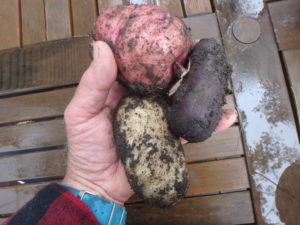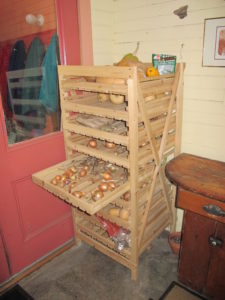It’s Time to Harvest and Store Root Crops
I sometimes wonder if I’m part squirrel. No, I don’t bury acorns for winter, but I do love putting up food for winter, especially potatoes. They’re the ultimate “comfort food” as far as I am concerned, and I rarely have too many. If you haven’t already done so, now is the time to harvest and store your potatoes for winter.
If you haven’t dug your potatoes yet, don’t worry. Potatoes store well in on ground right up to frost, and even after frost. But don’t try to overwinter them in the ground – they’ll get soft and unappealing. By now the leaves on my potato plants have yellowed and begun to die back, so there is no point in waiting- they won’t get any bigger. And if I wait too long, the mice may find them.
It’s important to be careful when digging potatoes so that you don’t damage any. I use a potato fork that has been in my family for decades. It’s like an ordinary garden fork, but the tines are at a right angle to the long handle, and are sharp and long. To harvest I pull the soil to one side with the potato rake. Then I plunge my fingers into the loose soil to find the spuds. If I spear a potato it goes into a pile destined for immediate consumption.
It is generally accepted that one should not wash potatoes fresh from the soil. Their skins are soft and easily damaged right after digging them. Most experts suggest hardening the skins by spreading them out in a cool place out of the sun for about a week. I do this on a north-facing deck, and turn over the potatoes after 2 or 3 days so both sides get hardened off.
Storing potatoes is best done by keeping them in a dark location with high humidity that stays between 35 and 50 degrees. Storing them in a warmer place will turn some of the starches in the potatoes into sugars. This will cause the potatoes to burn easily if you make French fries, so commercial growers keep them cool.
Potatoes need to breathe while in storage. They are living organisms that respire, so putting them in a sealed plastic bag will suffocate them, ruining them. Traditionally potatoes were stored in a cool basement with a dirt floor, but losses to mice or rats was often a problem.
I have a cool basement with a cement floor, and I have built a box there to contain buckets of potatoes and other root crops. It consists of two layers of blocks arranged in a rectangle, three blocks long and two wide. On top I have a piece of half-inch plywood. I call this my cool box, or root cellar. It will hold 6 buckets at a time. And so far, the rodents have not found a way in.
Carrots store well in my cool box. Like potatoes, they need a cool humid location for storage. I put an inch of moist sand in the bottom of each bucket to keep up the humidity.
Unlike potatoes, however, carrots will store well in the ground. In the past I have covered my carrots in the garden with a layer of straw or hay, then leaves. This acts as insulation and keeps the ground from freezing, allowing me to go out, shovel away the snow, and dig carrots in winter. Mice or voles have been an occasional problem, however. I put a stake in the ground at each end of the carrot bed so that I can find it in deep snow.
What else stores well in my cool box? Rutabagas, kohlrabi and celeriac – three less common root crops that I like – all store well cool, with high humidity. But onions do not store well in my cool box. They like a cool environment, but low humidity.
I store my onions and garlic in an area near the mudroom that stays cool but dry. I use a wooden “orchard rack” that I got from Gardener’s Supply many years ago. I also use it for winter squash. It has 6 large slatted drawers that pull out, allowing me to select what I need for dinner. It has excellent air circulation.
An old Vermont farmer I knew stored his winter squash upstairs under the bed in the guest room. He said he kept the radiator turned off so the room stayed cold, but above freezing. The humidity is naturally low in winter in most houses.
Last but not least, I have an ancient General Electric refrigerator in the basement that is not “frost-free”. This vintage fridge does not remove the moisture the way modern ones do, so ice will sometimes build up, requiring me to defrost it. But any vegetable that stores well in high humidity will do much better there than in a modern fridge which creates low humidity except in the two drawers at the bottom.
Part of my joy in gardening is spending time outdoors growing flowers and vegetables. Each fall I get busy putting up the vegetables for use in the kitchen all winter. And each time I make a stew with food I grew, I know my food is chemical-free and it tastes better to me because I grew it.
Henry Homeyer is a UNH Master Gardener and the author of 4 gardening books. See his blog posts at https://dailyuv.com/





